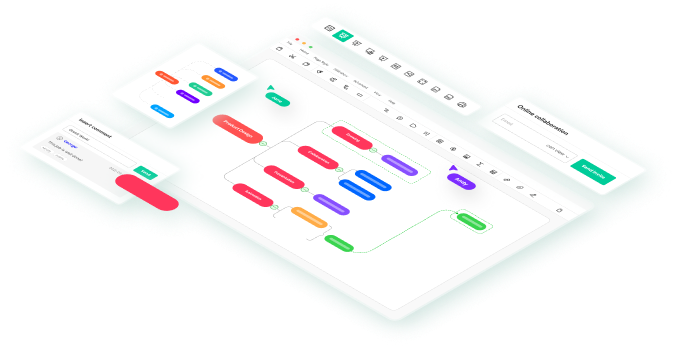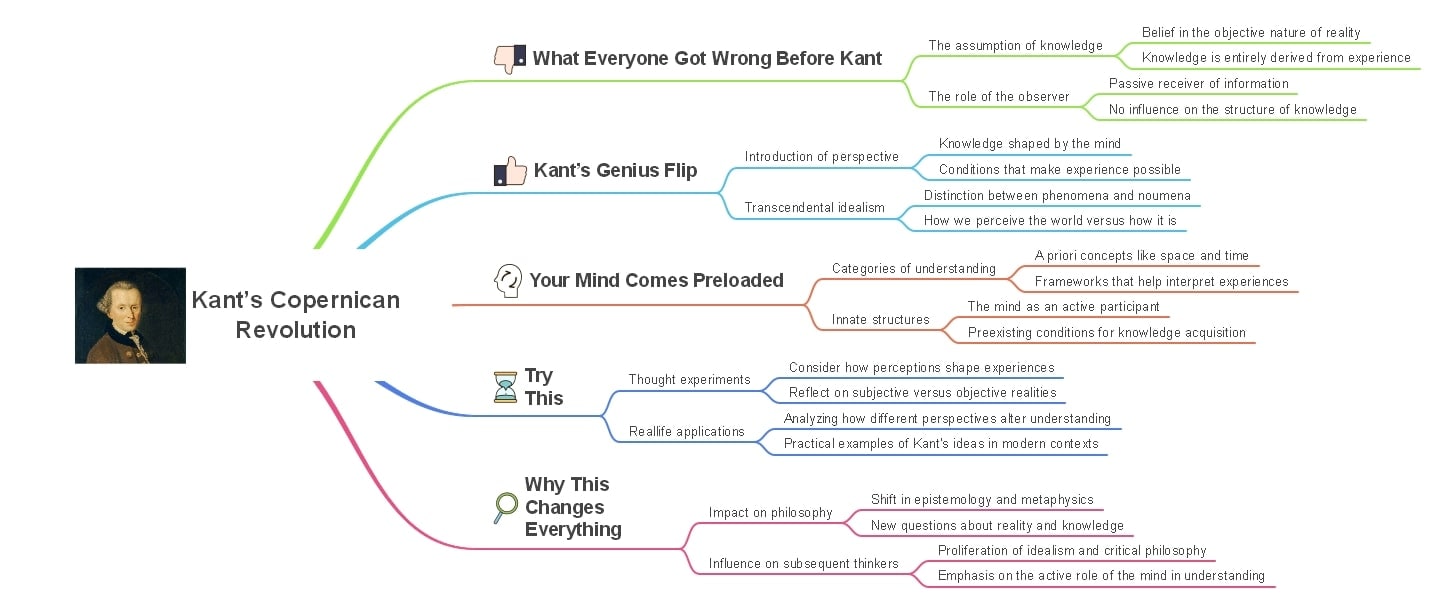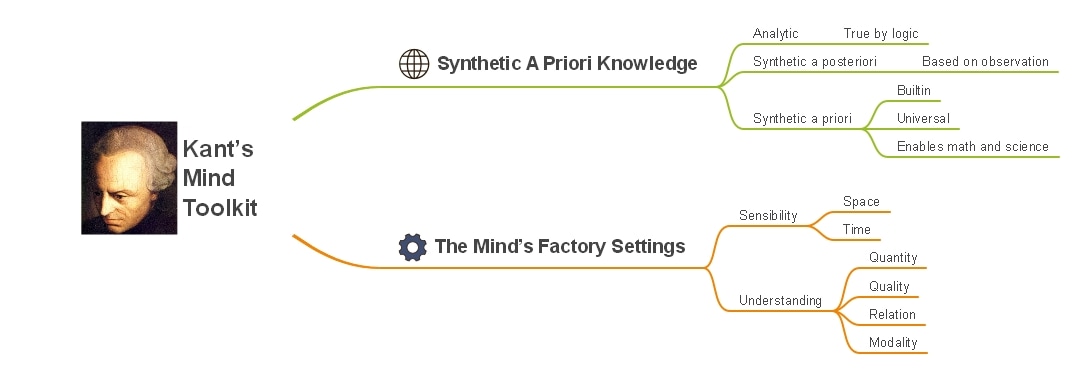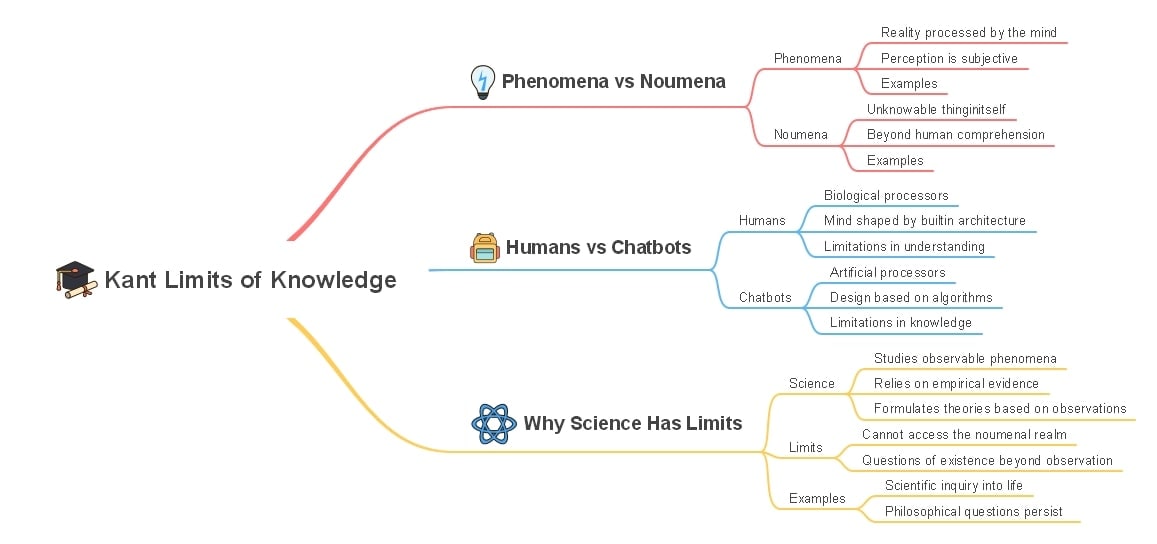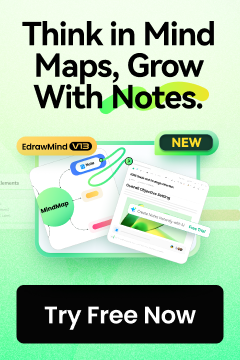Published in 1781, Kant's Critique of Pure Reason is one of the most referenced, but perhaps least understood books in philosophy. It asks a brutal question: What can we truly know?
Most Critique of Pure Reason summaries either oversimplify or drown in jargon. But if you've ever wondered why time feels universal, why cause-and-effect seems obvious, or why some truths feel "built-in," this book quietly explains it all.
And it still shapes how we think about science, perception, AI, and even your TikTok feed.
In this article, I'll break it down clearly, using examples that stick and tools that help you explore it faster.
In this article
The Copernican Revolution
What Everyone Got Wrong Before Kant
Before Kant, most thinkers saw the mind as a passive receiver.
Empiricists, such as Locke and Hume, believed that we learn everything through experience. You're born with an empty mind, and knowledge fills it up over time.
Rationalists like Descartes thought some truths (like math or logic) came built-in, independent of experience.
Both made progress, but neither could explain how we know things like "every effect has a cause" with such certainty, even though we don't see some truths actually in the world.
That gap was where Kant stepped in.
Kant's Genius Flip: From Passive to Active Mind
Kant's insight flipped the question on its head:
"What if the mind isn't shaped by the world, but the world is shaped by the mind?"
Think of it like this: Copernicus shocked the world by saying the Earth revolves around the sun, not the other way around. Kant made a similar move. He claimed reality, as we experience it, conforms to the structure of our mind.
This wasn't a poetic metaphor but a literal claim about how we perceive and understand everything.
Your Mind Comes Preloaded
Kant argued that the mind brings its own built-in "filters" to every experience. You never get the raw reality. Instead, you receive processed input, similar to a VR headset shaping what you see.
- Space and time are not "out there"; they're part of how your mind organizes experience.
- Causality isn't detected; it's projected by your brain to make sense of events.
In simpler terms, the mind isn't a blank page, but rather a formatting software for the experience itself.
Try This: You Can't Think Outside Time and Space
Here's how you know Kant was onto something: try to imagine an object that's not in space or time.
Go ahead.
Nothing comes to mind, right? That's because your mind simply won't process reality without those structures. Space and time are the conditions that make experience possible, not features of the outside world.
Why This Changes Everything
This was Kant's "Copernican revolution." Instead of assuming your knowledge must match external reality, he asked what must be true about the mind for experience even to occur.
That shift reframed everything:
- Why science works: because it's based on rules the mind brings to reality.
- Why math feels universal: because it reflects mental structures, not physical discovery.
- Why philosophy hit a wall: because it kept treating the mind as a mirror, not a constructor.
The Mind's Toolkit
Synthetic A Priori Knowledge
Kant introduced a third type of knowledge that neither empiricists nor rationalists could explain. It changed everything.
Let's break it down with a table:
| Type of Knowledge | Example | How We Know It | Why It Matters |
| Analytic | "All bachelors are unmarried." | By definition (logic) | True, but tells you nothing new |
| Synthetic a posteriori | "The sky is blue." | Observation (experience) | Adds info, but not always universally true |
| Synthetic a priori | "7 + 5 = 12", "Every effect has a cause" | Built into the mind | Universally true and necessary, even before experience |
This third category is the key. You don't learn that 7 + 5 = 12 from counting apples. You already know it before counting starts.
Kant argued that math and science work not because we discover reality "as it is," but because we're applying built-in mental rules to experience.
I first saw this click while studying Newton's laws. Physics isn't just observing; it assumes cause and effect, space, and time. Kant says those rules are baked into the human mind. That's why they feel universal.
The Mind's Factory Settings
Kant didn't stop at the types of knowledge. He went deeper, into how your mind structures all experience.
Sensibility's Framework (Where things appear):
- Space: Every experience must occupy a location.
- Time: Every experience must happen in sequence.
You don't choose this. Your brain forces it.
Understanding's Categories (How you think about what appears):
| Group | Categories |
| Quantity | Unity, plurality, totality |
| Quality | Reality, negation, limitation |
| Relation | Cause/effect, substance/accident |
| Modality | Possibility, existence, necessity |
You don't see these directly. But without them, nothing makes sense.
Practical Test: Tasting a New Fruit
Say you try a fruit you've never had.
Without effort, your mind:
- Places it somewhere (on your tongue).
- Logs the sequence (sweet → tangy).
- Assumes a cause (flavor came from fruit, not magic).
These aren't conclusions, they're conditions of perception. You couldn't not use them, even if you tried.
This part struck me personally while reviewing a memory of a traffic accident. I remembered the location, sequence, and cause. All those came built-in, not chosen, not optional. Kant explains why.
The Limits of Knowledge
Phenomena vs. Noumena
Kant drew a sharp line between two kinds of "reality":
- Phenomena = the world as you experience it
- Noumena = the world as it exists without your mind involved
You only ever know phenomena. That rose, you see? It's light waves, scent molecules, and touch, all processed by your brain.
What's a rose in itself? You'll never know. That's noumenon: the thing as it exists independently of you.
This wasn't just philosophical caution but a boundary line, a built-in limit. Just like you can't see infrared with your eyes, you can't access noumena with your mind.
I realized this while studying dreams. A dream feels real because your brain still applies concepts of space, time, and causality. But there's no external world behind it. In both dreams and waking life, your mind mediates what you call "reality."
Modern Parallel: Humans vs. Chatbots
Kant's framework makes sense of today's tech, too.
Think about me writing this article, or you reading it. We interpret input based on our architecture.
Now consider ChatGPT: it doesn't know anything, it just processes patterns based on its training.
We're not that different. Kant would say humans are biological processors, locked into a built-in code: space, time, causality, logic.
That doesn't make us fake. It makes us bounded.
Why Science Has Limits
Kant explained why science is powerful, but not all-powerful.
Science studies phenomena: what's observable, measurable, and testable.
However, in the noumenal realm, questions such as "Why does anything exist?" or "What is the soul?" can't be accessed through experiments.
You might say, "We just haven't discovered it yet." Kant would reply: it's not about time or tools but the fact that our minds can't handle unfiltered reality.
That hit me hardest during a course in neuroscience. Every brain scan gives us physical data. But consciousness? Still unexplained. Kant predicted that wall centuries ago.
Kant's Legacy in 2025
Psychology & Neuroscience
Kant argued that the mind structures experience before it happens. Today's predictive brain theory says the same thing.
Your brain doesn't just react, it guesses what's coming next based on past input, and then fills in the gaps. You see what your mind expects to see.
That's how illusions work. Or why you can mishear lyrics.
Kant didn't have fMRI machines, but he nailed the model: perception isn't passive, it's constructed.
The placebo effect is another example. Sugar pills trigger real biological effects, not because of the pill, but because of belief. That's Kant's point in action: your mind changes what's real for you.
Artificial Intelligence
Modern AI is built on architecture.
Just like humans can't think outside space and time, an AI can't "know" anything outside its training data and programmed structure.
Give two different AI models the same prompt, and you may get different outputs. Why?
Because their "categories", their internal logic, weights, and data, aren't the same.
Kant would say: No system perceives raw reality. Each system shapes what it knows based on its design.
This raises a deeper question:
If humans have synthetic a priori knowledge hardwired into us... could AI develop its own fixed mental rules?
It's no longer a purely philosophical question but design logic.
Social Media & Reality Bubbles
Your Instagram or TikTok feed looks nothing like mine.
Why? Because what you see is shaped by:
- Algorithms (structure, like Kant's categories)
- Your inputs (likes, scrolls, behavior)
It's not a shared reality, it's a personalized one.
That's Kant, again. You're not consuming reality, you're constructing it with filters you didn't even choose.
Social media just makes the mechanism obvious. Each of us lives in a different "phenomenal world," curated by technology, but built on mental software that Kant outlined over 200 years ago.
I saw this firsthand, comparing news feeds with a friend; we were living in parallel realities, not because of facts, but because of filters.
Key Takeaways from The Critique of Pure Reason
Kant's Critique is a manual, not a museum piece. It tells you how your mind processes reality, not just what to think, but how thinking works.
- You shape the world you see. Like a photo app with built-in filters, your mind adds structure, space, time, and cause before the experience even begins.
- Truth isn't out there, it's shaped in here. Math and physics feel universal because they match our brain's hardcoded structure.
- Some questions can't be answered, and that's part of the design. You can study how things appear, not what they are in themselves.
- Understanding this isn't optional anymore. From AI to social media, Kant's ideas explain why we live in fragmented realities, each filtered, structured, and unknowable in full.
Bonus: How to Read Critique of Pure Reason Quickly
Reading Kant cover to cover can take weeks. But if you're looking to understand it quickly, there's a simple, faster way. Here's how I use EdrawMind and its built-in AI to break down dense material like this:
Step 1: Extract the Text
- Open your PDF or browser version of Critique of Pure Reason.
- Copy any section you want to explore, whether it's a paragraph, chapter summary, or even the table of contents.
- Go to the Import button on the EdrawMind homepage and paste it in the Long Text tab into the AI file analysis window.
You can also upload images, doc, or PDF files for analysis if required.

Step 2: Let AI Structure It
- Hit the Start Parsing button to let it automatically extract key points, arguments, and visually structure them, saving you hours of note-taking.
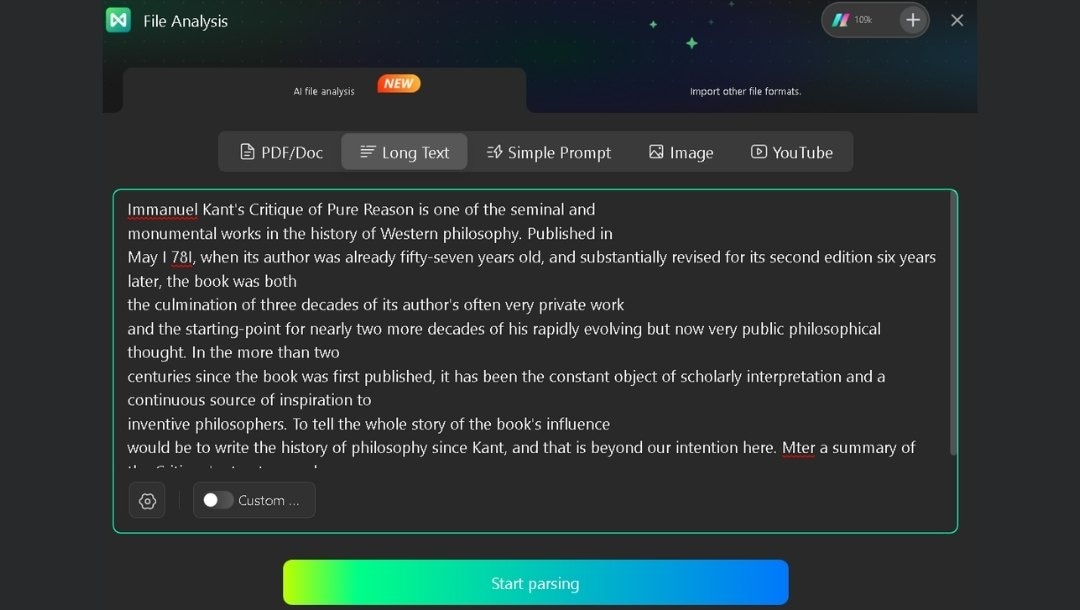
- Click Generate Mind Map to get a quick mind map of your text.
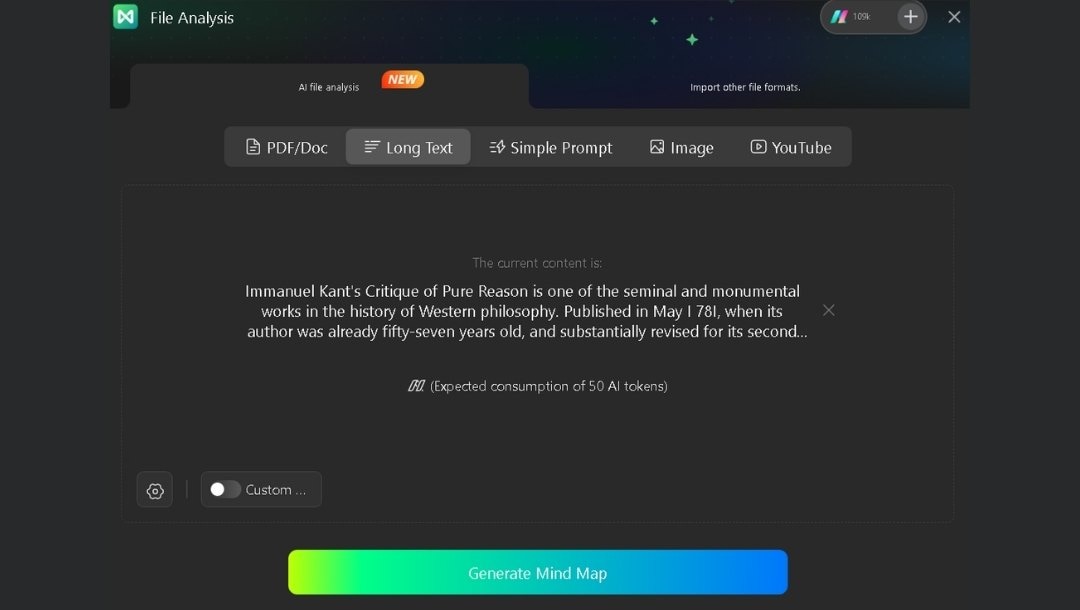
Step 3: Customize and Convert
- Once you get the mind map, convert it into:
- Outline for writing essays or summaries
- Slides for presentations or class reviews
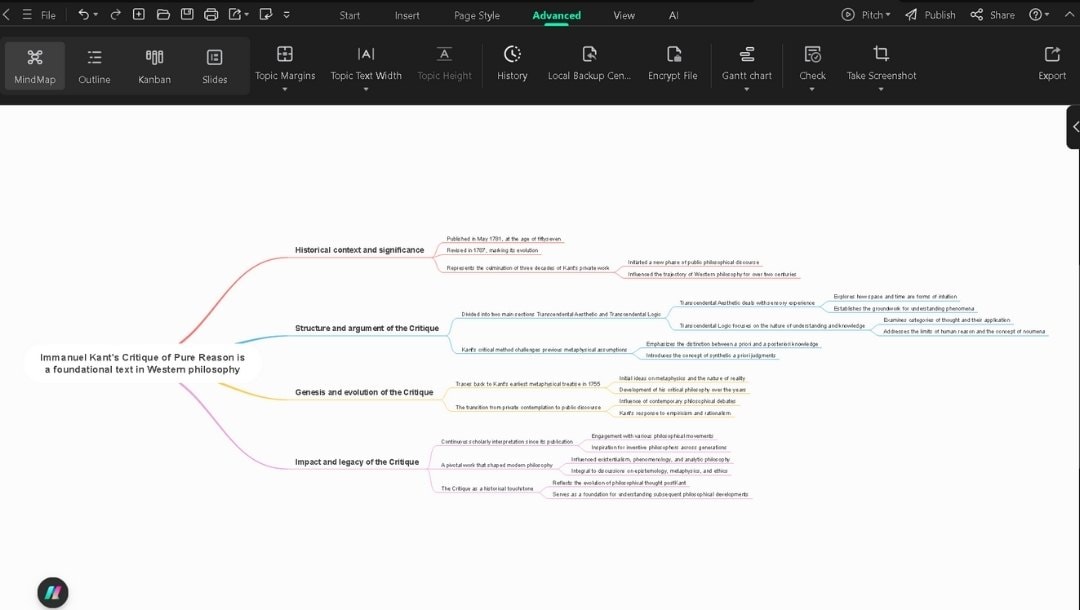
Other Useful AI Tools in EdrawMind
- AI Copywriting: Turn key ideas into bullet points or summaries
- AI Image Generation: Add visuals to abstract concepts (e.g., Kant's categories)
- Traverse Mode: Spotlight one idea at a time to avoid overload
Kant's work isn't short. But with the right tools, it doesn't have to be slow.
Start with a paragraph. Let EdrawMind do the heavy lifting. Then you just think.



